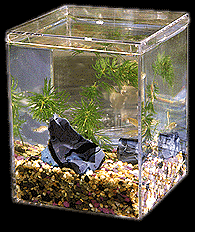Eco-Pros
Environmental Education on the Web
|
Coral
Communities |
Endangered Reefs |
Artificial Reefs |
Reef Resources |
ENDANGERED REEFS

|
Notice how the coloration of the fish match their surroundings? Many animals in all kinds of habitats can be found in areas where their colors blend into the surrounding rocks and plants. Some animals can change their own colors at will to camouflage (disguise) themselves so they will be overlooked by predators. In the picture above you can see how these fish can hide and become camouflaged within this environment. Below you will read why hiding will not even keep some marine life from harm. |
|
There are many stresses to coral reefs, both from natural causes and human activities.
Global warming is responsible for the destruction and severe degradation of a quarter of the world's coral reefs. Extreme climate changes are causing higher water temperatures. This causes algae living within coral to be expelled, which brings about coral bleaching and death to living polyps. Even a one-degree change can affect the survival of a reef. Outbreaks of Crown-of-Thorns starfish have damaged some coral reefs severely. Construction and logging can cause soil erosion which washes sediment down rivers and waterways into the ocean. This muddies the waters and prevents sunlight from reaching the coral.
Besides massive pollution, the harmful effects of global warming, Crown-of-Thorns starfish invasions, and other environmentally damaging human activities; many harmful methods are being used by humans to capture tropical species and coral to sell worldwide, mostly for home aquariums. Camouflage cannot help, nor can all the nooks and crannies in the coral offer protection as hiding spots, as you will see when you read the following:
DANGER IN THE REEF - NO PLACE TO HIDE TRAWLING - Indiscriminate
and large-scale seabed devastation is brought about by trawling, where the
sea bottom is completely leveled by heavy steel, chains and nets dragged by
fishing trawlers. Coral, plants and animals are all scraped up into huge
nets, leaving the ocean habitat below destroyed. It is estimated that 25
billion animals caught in these nets each year are thrown back into the sea as
garbage because they can't be sold. It takes centuries for a coral
reef to develop and a few minutes to destroy it by trawling! DYNAMITE - To stun the fish and bring them out of hiding, dynamite is exploded near the reef. This temporarily paralyzes hundreds of tropical fish and other species so the collectors can gather up huge amounts quickly. The concussion from the explosion kills many species. It takes centuries for a coral reef to develop and an instant for an explosion to destroy it! CYANIDE POISONING - Another damaging
and illegal hunting method is the use of cyanide
poisoning. The hunter squirts the cyanide in and around the coral to temporarily
immobilize sealife so they can be caught. But the poison floats around and
kills a great
amount of smaller fish and also the coral animals. U.S. Port Authorities inspectors are testing imported fish for cyanide poisoning. Most aquarium fish come from the Philippines and Indonesia. There are very loose laws in poorer countries for the protection of coral ecosystems. It is estimated that of tropical fish harvested, only one out of every ten survive.
|
|
|
||||
|
|
|
||
|
Learn
how to manage a healthy aquarium environment |
||
|
Be
environmentally responsible if you have an aquarium |
||
|
|


